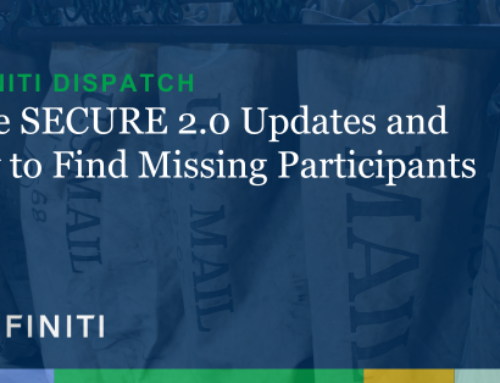VOL 5: UPDATES FOR THE NEW YEAR
On December 21, 2020, the House and Senate passed a $2.3 trillion omnibus appropriations and COVID-19 relief package, H.R. 133, the Consolidated Appropriations Act, 2021 (the “Act”). On December 27, 2020, President Trump signed the Act into law. The Act contains several provisions affecting qualified retirement plans. The key provisions are summarized below. Additionally, prior to the end of the year, the IRS released Notice 2020-86, which provides some needed guidance with regard to safe harbor provisions outlined in the SECURE Act.
Consolidated Appropriations Act, 2021
Partial Plan Termination Relief
Typically, a plan experiences a partial plan termination if there is a reduction of more than 20% of the number of covered participants during a plan year. In such circumstances, Code section 411(d)(3) requires a plan to fully vest the affected participants. The Act provides temporary relief from the partial plan termination rule for turnover due to COVID-19. Specifically, a plan will not incur a partial plan termination for any plan year that includes the period beginning March 13, 2020 and ending March 31, 2021, if the number of active participants covered by the plan on March 31, 2021 is at least 80% of the number of active participants covered by the plan on March 13, 2020. Essentially, this provision gives employers until March 31, 2021 to rehire laid off or furloughed workers (or hire replacement workers who would be eligible for the plan no later than March 31, 2021) to avoid a partial plan termination.
Traditional Disaster Relief
In response to recent hurricanes and wildfires, the Act provides special qualified disaster relief distributions, loans, recontributions, loan repayment suspensions and return of withdrawals for home purchases for qualified individuals. The rules under the Act for such distributions and loans are similar to the rules for the CARES Act and other natural disasters.
A qualified disaster area under the Act is any area declared a disaster by the President beginning on the period between January 1, 2020 and ending on February 25, 2021 (60 days after enactment of the Act) for disasters occurring from December 28, 2019 through December 27, 2020 (the enactment of the Act). A qualified disaster area does not include areas where the President has declared a disaster only on account of COVID-19.
A qualified individual is someone who resides in a qualified disaster area and who has sustained economic loss by reason of a qualified disaster.
Qualified individuals in 401(k), 403(b), money purchase pension and government 457(b) plans may take a withdrawal of up to $100,000 in aggregate from their retirement plan accounts without tax penalties. Income tax on these distributions may be spread ratably over a three-year period, or participants may recontribute the distribution into a qualified plan or IRA within the three-year period to avoid taxes and restore savings. Participants have until June 25, 2021 (180 days after enactment of the Act) to take qualified disaster distributions.
Further, such qualified individuals may take a plan loan of up to the lesser of $100,000 or 100% of the participant’s vested account balance beginning on December 27, 2020 and ending on June 25, 2021 (180 days after enactment of the Act). The Act also permits a delay in loan repayments for new and existing loans for a period of up to one year (or up to 180 days after enactment of the Act, if longer) if repayment of the loan normally would be due during the period beginning on the first day of the disaster incident period and ending 180 days from the last day of such incident period. When payments resume, the loan balance is reamortized to reflect accrued interest during the suspension period.
Coronavirus-Related Distributions (“CRDs”)
The Act does not extend the time available for plan participants to take a CRD. However, the Act expands the COVID-19 in-service distribution relief under the CARES Act to include money purchase pension plans. This provision is retroactive to the passage of the CARES Act in order to protect plan sponsors of money purchase plans who permitted such distributions during 2020.
Paycheck Protection Program (PPP) Tax-Related Changes
The Act permits employers to deduct otherwise deductible expenses, including contributions to a qualified plan, paid with PPP loan proceeds that are forgiven under the CARES Act. This reverses the IRS’s earlier guidance from Notice 2020-32 which stated that no deduction would be allowed for an eligible expense that is otherwise deductible if the payment of the eligible expense results in forgiveness of a covered PPP loan.
IRS Notice 2020-86
The SECURE Act made several changes to the rules for safe harbor plans, many of which left practitioners uncertain as to the application of such changes. The IRS released Notice 2020-86 (the “Notice”) on December 9, 2020, in a “question and answer” format, elaborating on these changes.
Adopting a Safe Harbor Plan, after a Suspension
As outlined in the SECURE Act, plan sponsors have the opportunity to amend their plan mid-year to be a safe harbor plan with nonelective contributions so long as the amendment is adopted before the 30th day before the end of the plan year (or before the last day of the following plan year if it requires the safe harbor nonelective contribution to be at least 4% of compensation).
The Notice provides clarity that an employer may re-adopt a safe harbor plan mid-year even if it had previously reduced or suspended its safe harbor nonelective contribution in the same plan year. The Notice further clarified that such plan will not be required to satisfy the ADP or ACP test (as applicable) or be subject to the top heavy rules for the plan year. This is welcome guidance for the many plan sponsors who suspended or reduced their safe harbor contributions either in reaction to or in anticipation of a loss of business due to the pandemic and resulting economic uncertainty. However, since the Notice was released less than 30 days before the end of the 2020 calendar year, if a plan sponsor wants to retroactively re-adopt a safe harbor plan with nonelective contributions for the 2020 calendar year, the nonelective contribution must be 4% of compensation for 2020.
The Notice clarified that the re-adoption of safe harbor status does not apply to plans where the plan sponsor reduced or suspended its safe harbor matching contribution mid-year. Further, the Notice explained that safe harbor nonelective contributions are only deductible for the prior plan year if made by the due date of the employer’s tax return (including extensions), even though the contributions may be made later than that in compliance with safe harbor requirements. Finally, the Notice explained that the guidance applies on similar terms to safe harbor 403(b) plans.
Other Safe Harbor Notice Information
The SECURE Act eliminated the requirement for a safe harbor notice for plans using the safe harbor nonelective contribution feature. However, practitioners were unclear as to whether the notice elimination applied to plan sponsors who fund a matching contribution deemed to satisfy the ACP test. The Notice explained that a safe harbor notice is required in such circumstances and further explained that if a plan sponsor wants to preserve the right to reduce or suspend the safe harbor nonelective contribution mid-year, the plan sponsor must provide a notice to employees regarding the potential suspension (i.e., a “maybe not” notice). The maybe not information can be included in the traditional safe harbor notice or as a standalone notice, so long as the maybe not information is provided no later than January 31, 2021 for the 2021 plan year.
QACA Clarification
The SECURE Act raised the maximum permissible deferral rate for qualified automatic contribution arrangements (“QACA”) to 15% of compensation from 10% of compensation for the second plan year and all subsequent plan years. The maximum deferral rate through the end of the first year remains set at 10% of compensation.
The Notice clarifies that employers are not required to increase the maximum qualified percentage of compensation for purposes of maintaining a QACA. Instead, the increased maximum default deferral rate is permissive so long as the percentage of compensation is applied uniformly, does not exceed the stated maximum percentage and does not fall below the required minimum percentage.
Nonetheless, the Notice indicates that plans that incorporate the maximum default deferral rate by reference to the Code will not fail to operate in accordance with its terms merely because the plan continues to apply the 10% maximum that applied prior to the SECURE Act. However, the plan would need to be amended by the SECURE Act deadline (generally, the end of the 2022 plan year) to clarify the maximum default deferral rate.
—
 Brooke Cozort is an ERISA Attorney with significant experience working on ERISA matters and qualified plans. She provides guidance on plan design considerations, operational compliance, fiduciary responsibilities, legislative and regulatory changes and industry trends.
Brooke Cozort is an ERISA Attorney with significant experience working on ERISA matters and qualified plans. She provides guidance on plan design considerations, operational compliance, fiduciary responsibilities, legislative and regulatory changes and industry trends.
BROOKE K. COZORT, JD CPC
ERISA Attorney | brooke.cozort@definiti-llc.com
This material has been prepared for informational purposes only, and is not intended to provide legal, tax, or investment advice. Any tax-related discussion contained in this material is not intended or written to be used, and cannot be used, for (i) avoiding any tax penalties, or (ii) promoting, marketing, or recommending to any other party any transaction or matter addressed herein. This material does not provide fiduciary recommendations concerning investments or investment management; it is not individualized to the needs of any specific benefit plan or retirement investor, nor is it directed to any recipient in connection with a specific investment or investment management decision. Please consult your independent legal counsel and/or professional tax advisor regarding any legal or tax issues raised in this material.
—





